
October 28, 1927
Los Angeles
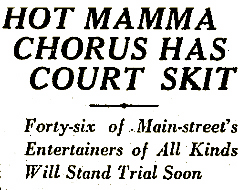 The vice bulls had a titillating time on Main Street tonight as they swooped down on the scantily-clad hot mammas of “Hot Mamma” at the Follies Theater, grabbing twenty-seven of the tiny-leaf’d gals and loading them into paddy wagons. Also arrested were twelve chorus men of the Hot Mamma show; further pinched were four tattooed women in their work clothes, and of course Ili Ili, the untamed tree-climbing South African pygmy (this last group in violation of Ordinance 6859, aka barking a show on the sidewalk, outside the Dreamland Palace at 539 South Main).
The vice bulls had a titillating time on Main Street tonight as they swooped down on the scantily-clad hot mammas of “Hot Mamma” at the Follies Theater, grabbing twenty-seven of the tiny-leaf’d gals and loading them into paddy wagons. Also arrested were twelve chorus men of the Hot Mamma show; further pinched were four tattooed women in their work clothes, and of course Ili Ili, the untamed tree-climbing South African pygmy (this last group in violation of Ordinance 6859, aka barking a show on the sidewalk, outside the Dreamland Palace at 539 South Main).

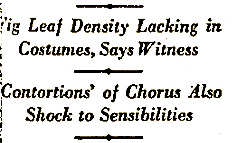 What gives? Well, it’s 1927, and saucy soubrettes kicking up their heels (oh you kid!) in the undesirable theaters of Street Main was too much for the dogooding Men of the Cloth, who remembered a time when there was no such flapping, before ladies in their runabouts had bathtub gin on the breath of a mouth slathered in kiss-proof lipstick and the men who love them, and so forth, and it was time to put a stop to it. On October 27, pioneering radio evangelists Dr. Gustav Briegleb and the Rev. Robert P. “Fighting Bob” Shuler took in the show at the Follies, and called in the coppers to shut it down tonight. On November 29, Shuler and Briegleb were called to the stand to testify as to the show’s indecency. Follies showgirls put on a good show at the Hall of Justice, too, as they loudly hissed the ministers. (Of course they hissed! Are they not serpents leading men astray as She did at the Fall of Man?!)
What gives? Well, it’s 1927, and saucy soubrettes kicking up their heels (oh you kid!) in the undesirable theaters of Street Main was too much for the dogooding Men of the Cloth, who remembered a time when there was no such flapping, before ladies in their runabouts had bathtub gin on the breath of a mouth slathered in kiss-proof lipstick and the men who love them, and so forth, and it was time to put a stop to it. On October 27, pioneering radio evangelists Dr. Gustav Briegleb and the Rev. Robert P. “Fighting Bob” Shuler took in the show at the Follies, and called in the coppers to shut it down tonight. On November 29, Shuler and Briegleb were called to the stand to testify as to the show’s indecency. Follies showgirls put on a good show at the Hall of Justice, too, as they loudly hissed the ministers. (Of course they hissed! Are they not serpents leading men astray as She did at the Fall of Man?!)
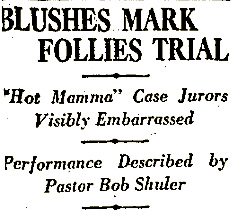 It’s a good thing counsel made a point of selecting an all-male jury, as the vivid descriptions of indecent dances, songs, jokes and costumes brought blushes to the faces of jurors, court spectators and court attaches during the trial. The highlight of the trial was Rev. Shuler himself, who read from his copious, filthy notes, which recounted a lewd performance between two girls playing the parts of deserted wives looking for their husbands in the barroom of a ship. And Shuler’s dead-on imitation of a “licentious smile” which he asserted to be part of the dancers’ repertoire brought such an outburst from the crowd of spectators (and the Hot Mamma girls) that the bailiff threatened to clear the courtroom.
It’s a good thing counsel made a point of selecting an all-male jury, as the vivid descriptions of indecent dances, songs, jokes and costumes brought blushes to the faces of jurors, court spectators and court attaches during the trial. The highlight of the trial was Rev. Shuler himself, who read from his copious, filthy notes, which recounted a lewd performance between two girls playing the parts of deserted wives looking for their husbands in the barroom of a ship. And Shuler’s dead-on imitation of a “licentious smile” which he asserted to be part of the dancers’ repertoire brought such an outburst from the crowd of spectators (and the Hot Mamma girls) that the bailiff threatened to clear the courtroom.
Preacher Briegleb minced no words: “They didn’t have enough clothes on to flag a handcar,” said he, and described the activities of the chorus as “a moving sea of contortions of all that was low and vile.” Defense counsel asked that the good minister confine himself to the facts, but what fun is that? In the dancers’ defense, Dorothy Walton, the blonde “Cleopatra” of the play, described her dancing as being “combinations of modern and classical steps” in which, she admitted, did in fact move every part of her body.

Which seemed hunky-dory with the aforementioned all-male jury, who set the lot free, save for four defendants—Tom B. Dalton, Robert Whalen, Harry Graves and Charles B. Dameron—found guilty based on their admitted connection with the management of the show and their writing of the dialogue. These Hot Papas were sentenced by Municipal Judge Frederickson to serve 150 days in the City Jail in addition to $500 ($5,515 USD2006) fines each: “It is my clearly defined duty to impose the severest sentence possible upon these defendants in order that such performances will not continue in this city…certainly the dances staged with their help were not artistic as claimed by them. The defendants have had a fair and unbiased trial and convicted of a most serious offense to society.”
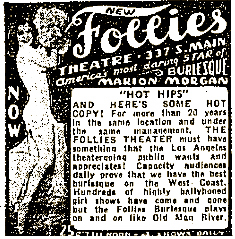 Needless to say, the Follies soldiered on. It was remodeled by S. Charles Lee in the 1930s, and thereafter saw many decades of shimmy-shammyin’ by Lili St. Cyr, Ann Corio and Betty “Ball of Fire” Rowland. Eventually girlesque went the way of vaudeville, and the Follies became a skin-flick house. In 1968 Eleanor Chambers, executive assistant to Mayor Yorty, led the fight to have the Los Angeles Cultural Heritage Board add the Follies to its list of culturally significant buildings (who had just added a theater and something art deco). The board nixed that idea as beneath them (rejecting the Burbank/Burlesk at 548 South Main as well).
Needless to say, the Follies soldiered on. It was remodeled by S. Charles Lee in the 1930s, and thereafter saw many decades of shimmy-shammyin’ by Lili St. Cyr, Ann Corio and Betty “Ball of Fire” Rowland. Eventually girlesque went the way of vaudeville, and the Follies became a skin-flick house. In 1968 Eleanor Chambers, executive assistant to Mayor Yorty, led the fight to have the Los Angeles Cultural Heritage Board add the Follies to its list of culturally significant buildings (who had just added a theater and something art deco). The board nixed that idea as beneath them (rejecting the Burbank/Burlesk at 548 South Main as well).
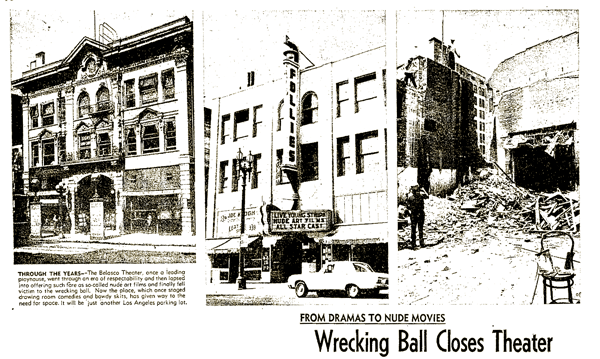
And then, in May of 1974—the month that the House of Representatives opened its impeachment hearings against President Nixon, the Follies was razed, and now, in its place, stands the Ronald Reagan building:
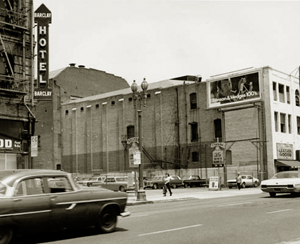
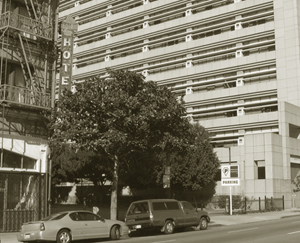
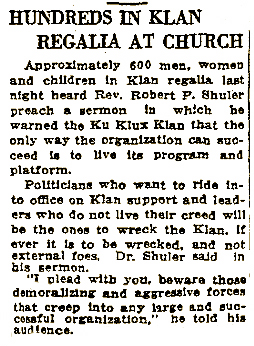
And oh yeah, for more on Revenend Shuler, go here…
…of course, they leave out all the obvious stuff…


 The vice bulls had a titillating time on
The vice bulls had a titillating time on 
 What gives? Well, it’s 1927, and saucy soubrettes kicking up their heels (oh you kid!) in the undesirable theaters of Street Main was too much for the dogooding Men of the Cloth, who remembered a time when there was no such flapping, before ladies in their runabouts had bathtub gin on the breath of a mouth slathered in kiss-proof lipstick and the men who love them, and so forth, and it was time to put a stop to it. On October 27, pioneering radio evangelists Dr. Gustav Briegleb and the Rev. Robert P. “
What gives? Well, it’s 1927, and saucy soubrettes kicking up their heels (oh you kid!) in the undesirable theaters of Street Main was too much for the dogooding Men of the Cloth, who remembered a time when there was no such flapping, before ladies in their runabouts had bathtub gin on the breath of a mouth slathered in kiss-proof lipstick and the men who love them, and so forth, and it was time to put a stop to it. On October 27, pioneering radio evangelists Dr. Gustav Briegleb and the Rev. Robert P. “ It’s a good thing counsel made a point of selecting an all-male jury, as the vivid descriptions of indecent dances, songs, jokes and costumes brought blushes to the faces of jurors, court spectators and court attaches during the trial. The highlight of the trial was Rev. Shuler himself, who read from his copious, filthy notes, which recounted a lewd performance between two girls playing the parts of deserted wives looking for their husbands in the barroom of a ship. And Shuler’s dead-on imitation of a “licentious smile” which he asserted to be part of the dancers’ repertoire brought such an outburst from the crowd of spectators (and the Hot Mamma girls) that the bailiff threatened to clear the courtroom.
It’s a good thing counsel made a point of selecting an all-male jury, as the vivid descriptions of indecent dances, songs, jokes and costumes brought blushes to the faces of jurors, court spectators and court attaches during the trial. The highlight of the trial was Rev. Shuler himself, who read from his copious, filthy notes, which recounted a lewd performance between two girls playing the parts of deserted wives looking for their husbands in the barroom of a ship. And Shuler’s dead-on imitation of a “licentious smile” which he asserted to be part of the dancers’ repertoire brought such an outburst from the crowd of spectators (and the Hot Mamma girls) that the bailiff threatened to clear the courtroom.
 Needless to say, the Follies soldiered on. It was remodeled by
Needless to say, the Follies soldiered on. It was remodeled by 



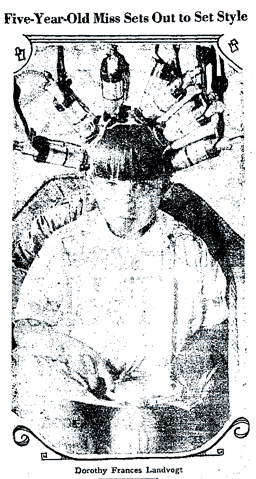










 October 12, 1927
October 12, 1927

